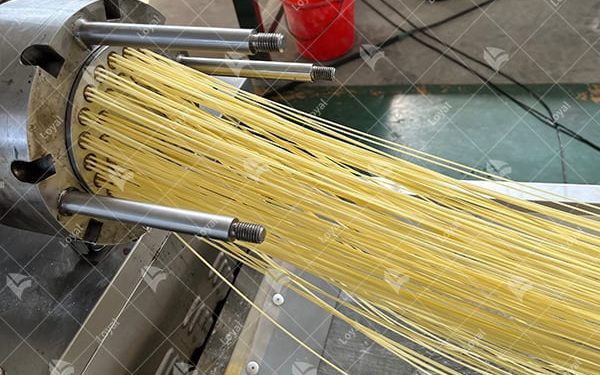What is a spaghetti production line and how does it work?
Understanding the Components of a Pasta Production Line
A pasta production line consists of an arrangement of a couple of machines that are sequentially linked, and each of the machines performs a specific operation during the process. A typical line starts with a mixing unit. For example, flour and water are mixed together to make the dough. Then follows the extrusion machine, which turns the dough into spaghetti strands. The next on the line is a drying system, which lowers the moisture content, ensuring the product is of good quality and can last longer. Also, there’s an automatic cutting and portioning unit that cuts the pasta into the required sizes. Last but not least, the packaging machinery wraps the ready product with materials that can protect the product during distribution.
If you are looking for more information about Spaghetti Production Line – Loyal go here right away
The Spaghetti Production Process: From Dough to Packaging
The very first step towards making spaghetti is to combine semolina flour and water together in a way that makes a dough that is uniform. Once the dough reaches uniformity, it is pushed through custom-made hollows to create the desired spaghetti shape. After the dough goes through extrusion, it proceeds to a part where it is just dried lightly so that the form spaghetti has been set into place. Following this part, there is the main drying phase, which removes the water content of the product to a level that would make the chances of it going bad extremely slim. Once the water content reaches a desirable level, the pre-set lengths of spaghetti are cut and sent to packaging. Here the spaghetti is vacuum sealed while being labelled and wrapped, this makes sure that the spaghetti can later be ready to be sold or distributed.
View Spaghetti Production Line – Loyal for More Details
Automation and Technology in Modern Spaghetti Production
- Automated Mixers: Blending of the ingredients to form dough is done precisely, this guarantees a uniform quality for the dough.
- Extrusion Technology: Flexible dies for diverse pasta cross-sections and sizes.
- High Quality Advanced Drying Systems: Control of parameters for optimal drying process.
- Cutters: Accurate marking and cutting of spaghetti according to specified lengths.
- Self-Sufficient Packaging: Connection of operation sealing, boxing, and quality control measures.
- Real-Time Monitoring Systems: Enable the production parameters to be changed remotely.
Such advancement and automation of processes contribute to the better organization of the workflow, improving conformity of the end product, as well as reduce the manpower required significantly.
Why invest in an industrial spaghetti production line?
Increasing Output and Efficiency in Pasta Manufacturing
- High-Capacity Mixers: Use larger dough volume mixers so that the mixing time can be reduced which will in response increase production output.
- Optimized Extrusion Technologies: Upgrade old exhibition configuration with modern ones to enhance the output flow rate and reduce maintenance interruptions.
- Integrated Workflow Systems: Integrate a full-range application that would connect all the stages of the process together to utilize efficiency.
Ensuring High-Quality Product Consistency
- Precision Quality Control Instruments: Use sensors and cameras for advanced measurement of structured dough places such as noodles in order to control its size, shape and texture.
- Consistent Ingredient Sourcing: Find reliable contacts for suppliers of the raw materials that will enable repeatable flavor and texture attributes.
- Controlled Environmental Conditions: Control the temperature within the production plants to eliminate variances in product likeness.
Reducing Labor Costs Through Automation
- Automated Material Handling: Automate as much as possible the movement of the ingredients and the final products by applying conveyor belts and robots limiting the manual labor.
- AI-Powered Systems: Integrate artificial intelligence for maintenances prior analysis and production planning.
- Comprehensive Training for Staff: Employ skilled individuals, train them as much as you can so that automation reduces human interdependency significantly.
What features should you look for in a spaghetti production line?
Key Equipment
Mixers, Extruders, and Dryers
Consider mixers, extruders, and dryers as the crucial elements of a spaghetti production line. To meet the extruder’s performance requirements, large mixers are needed to completely mix the dough ingredients to obtain a uniform consistency. High capacity advanced extruders will form the dough into a long shape with effective and efficient processes. Robust drying systems are essential since they ensure that the moisture is removed from various parts of the pasta without it losing its structure thus allowing for extended shelf life and good quality products.
Vacuum Technology and Temperature Control – A Necessity in Commercial Pasta Production
Temperature control is also important as it defines the quality and texture of the final product in the pasta making process. The traditional method of replacing the cores mechanical design with a vacuum extrusion technology in the production system greatly increases the quality of the pasta by removing and air pockets likely to weaken the structure of the final product. These features when properly controlled enables large scale production of spaghetti with specific characteristics.
What Role Does Customisation Play in Pasta Making?
Contemporary means of production give a broad capability of customization including the production of shapes other than spaghetti. Several adjustments to dies and molds in the extrusion system aid in making a wide range of pasta to satisfy the market needs or consumer preferences. This autonomy not only increases the product range but also increases the competitive edge by addressing certain needs of the clientele.
How to choose the right spaghetti production line manufacturer?
Evaluating Production Capacity and Line Specifications
When considering the manufacturer of a spaghetti line, it is very important to determine the output and line characteristics suitable for your requirements. Of paramount importance are the output of the machine, its flexibility in making other shapes of pasta and its compatibility with other machines and systems. All these parameters will affect not only the efficiency of production at this stage, but also the capability to ramp up production in the future in case of increased requirements.
Evaluating Technical Support and After Sale Services
To be assured of a successful and operational business in the future, after sales support and technical assistance are critical ingredients for a firm. Manufacturers should deliver clients with a follow up not only for the beginning of business but also for the middle and end through adequate training, maintenance and fast assistance to issues. In turn, this will ensure low downtimes and high productivity of the production line. Considerable effects can be realized through assessing the time it takes the manufacturer to respond to issues and the ability of the support team in ensuring that things run smoothly.
Quote Comparison Value for Money
It is worth noting that when comparing quotes from a variety of producers it is not a simple case of analyzing price alone; the value for money assessment comes into play here. It is important in this regard to assess such equipment attributes as their life span, energy consumptive capacity, warranty and other essential add-ins that come with offer. Close scrutiny allows one to choose the producer who offers the most suitable price and value in the long term.
What are the maintenance requirements for a spaghetti production line?
Regular Cleaning and Sanitation Procedures
To ensure the quality of spaghetti as well as the sanitary requirements, periodic or regular cleaning and decontamination of the production line is a must. This also includes cleaning the equipment on a daily basis to eliminate the remnants of cooked pasta that could pollute the area. Furthermore, daily deep cleaning services should be performed, where the major parts are disassembled, and food grade detergents and sanitizers are used to thoroughly clean the items. To ensure compliance with sanitization procedures, detailed records of cleaning operations should be kept.
Preventive Maintenance Schedules
To reduce the likelihood of dealing with unforeseen equipment malfunctions, and to maximize the equipment’s useful life, a preventive maintenance schedule should be established. These include servicing and maintaining various mechanical components, checking sensor readings, ensuring moving parts are lubricated, and changing parts that are no longer viable. More comprehensive investigative checks regarding how the machines perform, and where wear may occur, should be conducted once a month, whereas a semi-annual evaluation should be able to determine if there are deeper mechanical problems that should be fixed.
Troubleshooting Common Issues in Pasta Production
- Irregular Pasta Shape: May indicate issues with the extrusion dies or inconsistent amount of water in the dough. Remove the blockage from the die and examine the moisture content of the dough.
- Motor Overheating: This can result from over working the machine or lack of sufficient lubrication. Check that the motor is functioning within the specified load and lubricate bearings consistently.
- Variations in Cutting Length: The cause of the variations can most probably be stuck blades or offset cutting mechanisms. Inspections and adjustments of blades need to be done periodically in order to ensure perfect.
- Long Interruption Times: Many of the interventions from the operators are connected with minor breakdowns of mechanisms or electronic malfunctions; keeping a precise record of equipment problems documentation could help understand the reasons and deficiencies of the equipment which can be targeted for further maintenance activities.
How can you maximize ROI with your spaghetti production line?
Optimizing Production Processes for Efficiency
In order to enhance the efficiency of all pasta production, it is important to manage processes and waste. Lean manufacturing techniques can cut the idle time and increase the outflow. For instance, restructuring the plant’s layout in such a manner so that motion and physical stress are reduced and movement requirements are met will cause operations to be more efficient. Labor Cost and placement accuracy that ensures better quality can also be solved through automation.
All Types and All Shapes of Pasta
Increasing the number of types and shapes of pasta may help to reach a wider audience and new market areas. Consider producing alongside the traditional varieties such as spaghetti or penne, some specialty shapes such as orecchiette or fusilli. All these have their own characteristics and allow for different setting parameters such as the temperature inside the extruder and the time the product dries relative to its type.
Energy-Efficient Actions
- Modernize Appliances: Change outdated appliances to modern energy efficient ones that require less energy.
- Improve Insulation: Thermal losses caused by suboptimal insulation on ovens and refrigeration units can be minimized.
- Employ Activity Control Processes: Modern systems that help observe energy usage in the course of production and control activities in the production line can be put in place.
- Employ Pasta Drying Aids: Use systems that collect and transport back all the waste thermal energy obtained from dried pasta.
- Installation of LED Lighting: Replace regular lights with LED sources to cut costs on electricity and the amount of heat generated.









































































